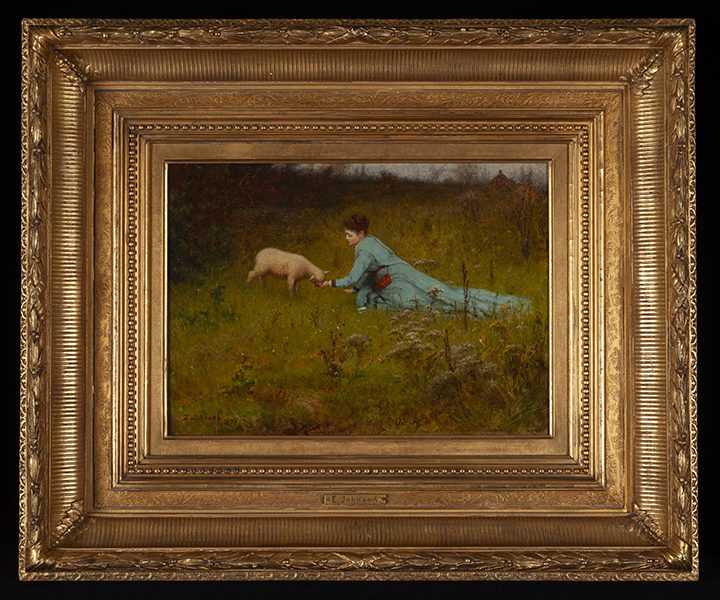Fenimore Art Museum Announces Acquisition of Eight Major Artworks for Its American Art Collection
Cooperstown, New York — Fenimore Art Museum announced yesterday that it has acquired eight major works of art including works by Eastman Johnson, William Merritt Chase, John Singer Sargent, Childe Hassam, Maurice Prendergast, Joshua Johnson, and Georgia O’Keeffe. Acquisition of these works was generously funded by the Eugene V. and Clare E. Thaw Charitable Trust.
The acquisitions highlight the museum’s effort to expand its already significant collection of American art. This group broadens the scope to include major works created from the 1870s to about 1930, allowing the museum to tell the story of American art and culture as it evolved after the Civil War.
“We are looking forward to sharing these magnificent acquisitions with our audiences,” said Dr. Paul S. D’Ambrosio, Fenimore Art Museum President and CEO. “Moving forward, our goal is to create a renowned collection of American art that builds upon the early and mid-nineteenth-century works left to the museum by our original benefactor Stephen C. Clark. Likewise, we continue the legacy of the generous gift of the Eugene and Clare Thaw Collection of American Indian Art given to us in 1995 by the Thaws and housed in a new wing funded by Clark’s granddaughter, Jane Forbes Clark.”
The new works are currently on view through December 31 and will also be on display throughout the 2024 season beginning April 1. Visit FenimoreArt.org.
Included in this group of acquisitions are:
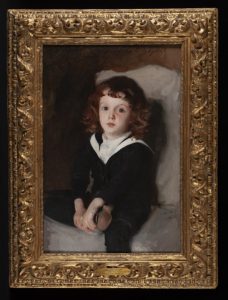
Portrait of Laurence Millet (1887), John Singer Sargent (1856-1925). Oil on canvas. Collection of Fenimore Art Museum, Cooperstown, New York. Gift of Eugene V. and Clare E. Thaw Charitable Trust N0013.2023. Photograph by Richard Walker.
John Singer Sargent (1856-1925)
Portrait of Laurence Millet, 1887
Oil on canvas
Collection of Fenimore Art Museum, Cooperstown, New York
Gift of Eugene V. and Clare E. Thaw Charitable Trust N0013.2023
Photograph by Richard Walker.
The Millets were a prominent New England family and close friends with Sargent. Laurence’s father, Frank, was an artist and often painted with Sargent at Broadway, a quiet Cotswold village frequented by wealthy artistic Americans. Sargent’s portrait of Laurence is informal, showing the boy at age three, seated with one foot pulled up on his knee. He wears a sailor suit, with his face framed with long curly locks of brown hair. This work was a gift from the artist inscribed to Laurence’s mother, Lily, which speaks to the intimacy and affection Sargent held for the Millet family.
Georgia O’Keeffe (1887-1986)
Brown and Tan Leaves, 1928
Oil on canvas
Collection of Fenimore Art Museum, Cooperstown, New York
Gift of Eugene V. and Clare E. Thaw Charitable Trust N0014.2023
Photograph by Richard Walker.
Between the years 1918-1934, O’Keeffe spent extended summers at Alfred Stieglitz’s family estate, located just north of Lake George Village, New York. She found herself inspired by the area, creating over 200 works representing an abstract and modernist take on panoramic views of the lake, mountains, close ups of trees, flowers, and barns as well as intimate, yet monumental studies of leaves. O’Keeffe often collected leaves that appealed to her for their striking diversity of shape and color. She created twenty-nine leaf paintings between 1922 and 1931, all based on leaves she’d found and collected while at Lake George.
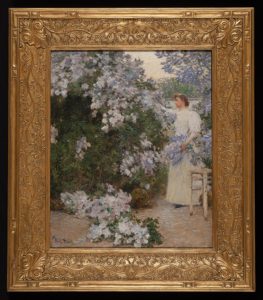
Mrs. Hassam in the Garden (1896), Childe Hassam (1859-1935). Oil on canvas. Collection of Fenimore Art Museum, Cooperstown, New York. Gift of Eugene V. and Clare E. Thaw Charitable Trust N0017.2023. Photograph by Richard Walker.
Childe Hassam (1859-1935)
Mrs. Hassam in the Garden, 1896
Oil on canvas
Collection of Fenimore Art Museum, Cooperstown, New York
Gift of Eugene V. and Clare E. Thaw Charitable Trust N0017.2023
Photograph by Richard Walker.
By 1896, Hassam had begun to attain artistic maturity and success. As noted by a critic from The New York Times, “…He seems able to paint anything his fancy dictates. He can be as finished, as broad, as impressionist, as colorful as the best of them, and all at will.” The origin of Hassam’s light palette and interest in the theme of women and flowers coincided with an extended stay in France in 1886. While there he studied and adopted aspects of the Impressionist technique and choice of subject matter, molding them to suit his own aesthetic objectives.
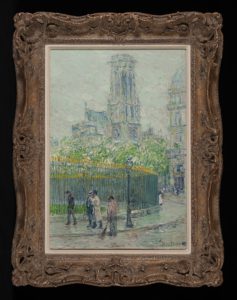
St. Germain l’Auxerrois (1897), Childe Hassam (1859-1935). Oil on canvas. Collection of Fenimore Art Museum, Cooperstown, New York. Gift of Eugene V. and Clare E. Thaw Charitable Trust N0018.2023. Photograph by Richard Walker.
Childe Hassam (1859-1935)
St. Germain l’Auxerrois, 1897
Oil on canvas
Collection of Fenimore Art Museum, Cooperstown, New York
Gift of Eugene V. and Clare E. Thaw Charitable Trust N0018.2023
Photograph by Richard Walker.
Childe Hassam first travelled to France in 1886, staying for three years and observing the Impressionist work around him. It was on this trip that he first depicted the neo-Gothic church of St Germain l’Auxerrois, near the picturesque banks of the Seine. Hassam returned to Paris once more in 1897, when the present work was painted. Depicting the grand structure amidst the bustling Parisian day, Hassam tenderly captures the liveliness of the city in which he worked. Like the French Impressionists he admired, Hassam selected a quotidian subject and likely painted this scene en plein air, or directly on-site.
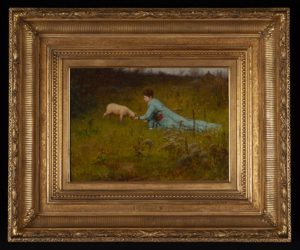
The Pet Lamb (1873), Eastman Johnson (1824-1906). Oil on canvas. Collection of Fenimore Art Museum, Cooperstown, New York. Gift of Eugene V. and Clare E. Thaw Charitable Trust N0016.2023. Photograph by Richard Walker.
Eastman Johnson (1824-1906)
The Pet Lamb, 1873
Oil on canvas
Collection of Fenimore Art Museum, Cooperstown, New York
Gift of Eugene V. and Clare E. Thaw Charitable Trust N0016.2023
Photograph by Richard Walker.
Johnson began summering in Nantucket in 1870 and formulated his own Nantucket aesthetic, drawing directly on the visual character of the place and the tenor of life on the island. In the 1870s critics set up an intriguing rivalry between Johnson and Winslow Homer. The Pet Lamb is one of such images done during his time on Nantucket in which we see Johnson depicting a subject Homer tended to favor—a lone women in nature surrounded by the vastness of the terrain. Perhaps Johnson is also drawing a parallel between the compliant nature of the lamb and the behavior expected from women in 19th century American high society.
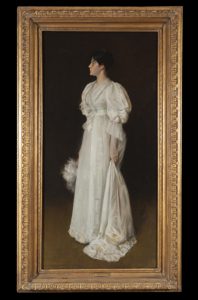
The Lady in White (1894), William Merritt Chase (1849-1916). Oil on canvas. Collection of Fenimore Art Museum, Cooperstown, New York. Gift of Eugene V. and Clare E. Thaw Charitable Trust N0019.2023. Photograph by Richard Walker.
William Merritt Chase (1849-1916)
The Lady in White, 1894
Oil on canvas
Collection of Fenimore Art Museum, Cooperstown, New York
Gift of Eugene V. and Clare E. Thaw Charitable Trust N0019.2023
Photograph by Richard Walker.
Chase painted many portraits of his wife, Alice Gerson Chase, over the course of their marriage. Although Alice is the model for this work, he didn’t intend for it to be perceived as a portrait, but rather a study of a white satin dress. Having been trained at the Royal academy in Munich, he was a master practitioner of bravura brushwork. He rarely did preparatory drawings or paintings for his major works.The Lady in White is a prime example of the Chase method of painting—direct application of the loaded brush to the canvas with unerring ability.
Joshua Johnson (ca. 1763-ca. 1824)
Seated Girl with Strawberries, ca. 1803-1805
Oil on canvas
Collection of Fenimore Art Museum, Cooperstown, New York
Gift of Eugene V. and Clare E. Thaw Charitable Trust N0015.2023
Photograph by Richard Walker.
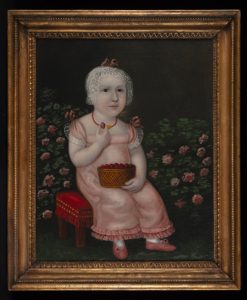
Seated Girl with Strawberries (ca. 1803-1805), Joshua Johnson (ca. 1763-ca. 1824). Oil on canvas. Collection of Fenimore Art Museum, Cooperstown, New York. Gift of Eugene V. and Clare E. Thaw Charitable Trust N0015.2023. Photograph by Richard Walker.
Joshua Johnson is considered America’s first professional African American portrait painter. He was first identified by name in 1939 by the scholar J. Hall Pleasants, yet he remains an enigmatic figure. Seated Girl with Strawberries ranks among his very best likenesses of a child, notable for the inherent beauty of the sitter, her distinctively pleasant expression, the vibrancy of her pink dress and red shoes. The seated figure is unique for Johnson as he usually depicted children standing in his signature flowering garden. Here, the girl holds a strawberry in a half-raised right arm, a pose Johnson used in several other portraits done in the same period.
Maurice Brazil Prendergast (1859-1924)
Snowy Day, Boston, ca. 1907-1910
Oil on canvas
Collection of Fenimore Art Museum, Cooperstown, New York
Gift of Eugene V. and Clare E. Thaw Charitable Trust N0021.2023
Photograph by Richard Walker.
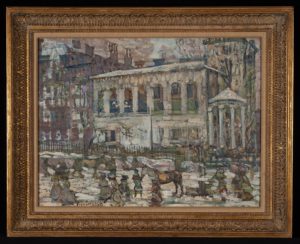
Snowy Day, Boston (ca. 1907-1910), Maurice Brazil Prendergast (1859-1924). Oil on canvas. Collection of Fenimore Art Museum, Cooperstown, New York. Gift of Eugene V. and Clare E. Thaw Charitable Trust N0021.2023. Photograph by Richard Walker.
Prendergast spent three years in Paris studying at the Académie Colarossi and the Académie Julian. In Paris he discovered the styles and influence of the Post-Impressionists, including Cézanne, Édouard Vuillard and Pierre Bonnard. Adapting Cézanne’s expressive use of color and form, Prendergast developed a highly personal style with boldly contrasting, jewel-like colors, and flattened, patternlike forms rhythmically arranged on a canvas. Like many of his other works, Snowy Day, Boston, which depicts Brimstone Corner by the Park Street Church in Boston, has been described as tapestry-like or resembling a mosaic.
About Fenimore Art Museum
Fenimore Art Museum, located on the shores of Otsego Lake—James Fenimore Cooper’s “Glimmerglass”—in historic Cooperstown, New York, features a wide-ranging collection of American art including folk art; important American 18th- and 19th-century landscape, genre, and portrait paintings; more than 125,000 historic photographs representing the technical developments made in photography and providing extensive visual documentation of the region’s unique history; and the renowned Eugene and Clare Thaw Collection of American Indian Art comprised of nearly 900 art objects representative of a broad geographic range of North American Indian cultures, from the Northwest Coast, Eastern Woodlands, Plains, Southwest, Great Lakes, and Prairie regions. Visit FenimoreArt.org.
Museum Hours
Fall/Winter hours (October 10–December 31): 10:00 a.m.–4:00 p.m., Tuesday through Sunday (closed Mondays, Thanksgiving, and Christmas). Museum admission is free for visitors 19 and under. Find more information at FenimoreArt.org.

